Value Chain Engineering: Analyzing Complaints & Solutions
VerifiedAdded on 2023/06/14
|11
|1958
|149
Report
AI Summary
This report provides an analysis of customer complaints within the supply chain process of an electronics distribution company. The study identifies the root causes of these complaints, focusing on packaging, damaged products, and poor customer service response. Through data analysis of 719 customer complaints, the report uncovers issues such as barcode fraud, order picking inaccuracies, unskilled employees, and unsuitable warehouse layouts. Recommendations include implementing an action plan for equipment maintenance, using RFID technology to prevent theft, and providing staff training to improve handling of equipment and technology. The goal is to enhance the distribution center's efficiency, reduce complaints, and improve customer satisfaction by addressing operational issues and modifying current supply chain practices. Desklib provides access to similar solved assignments and past papers for students.
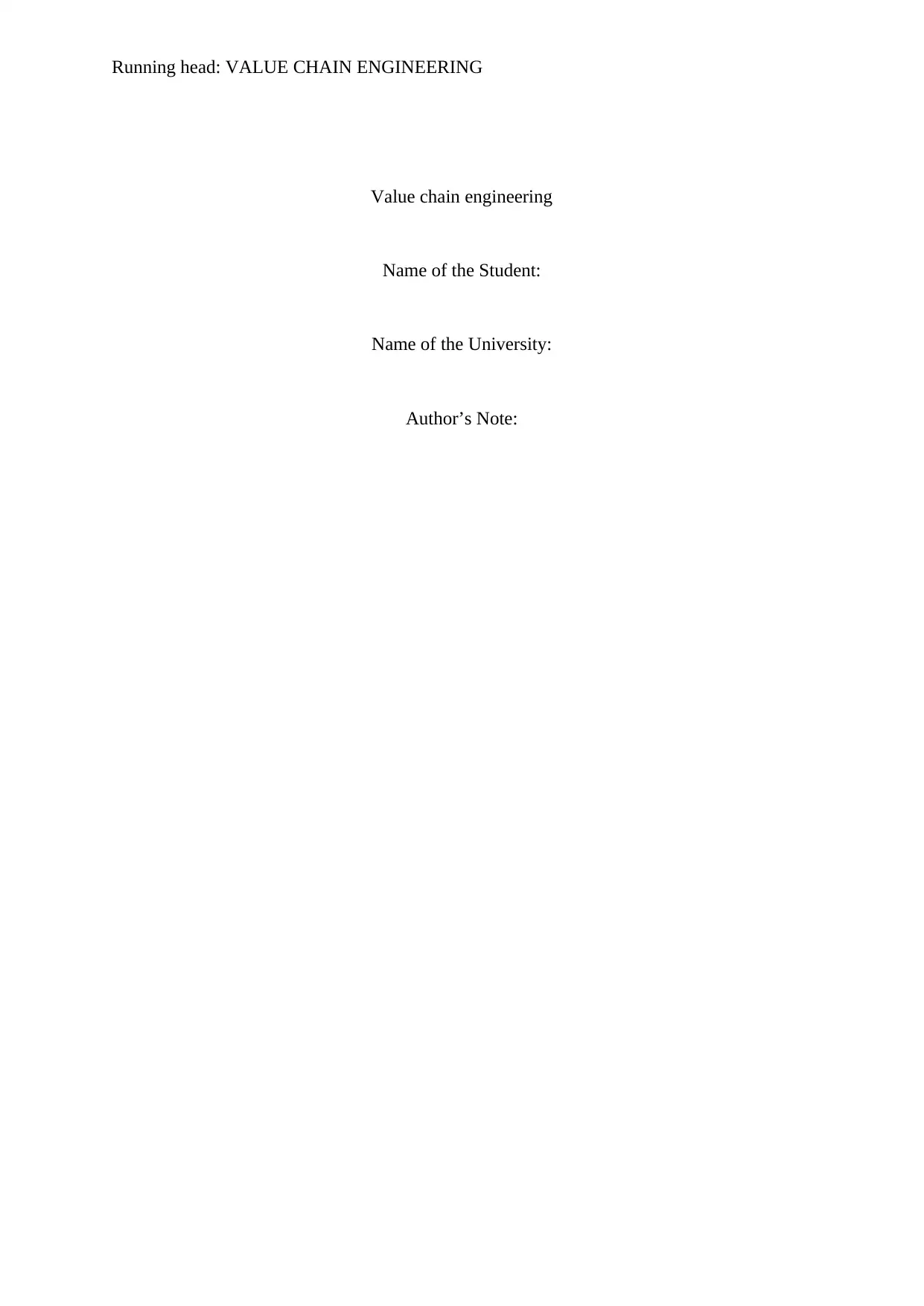
Running head: VALUE CHAIN ENGINEERING
Value chain engineering
Name of the Student:
Name of the University:
Author’s Note:
Value chain engineering
Name of the Student:
Name of the University:
Author’s Note:
Paraphrase This Document
Need a fresh take? Get an instant paraphrase of this document with our AI Paraphraser
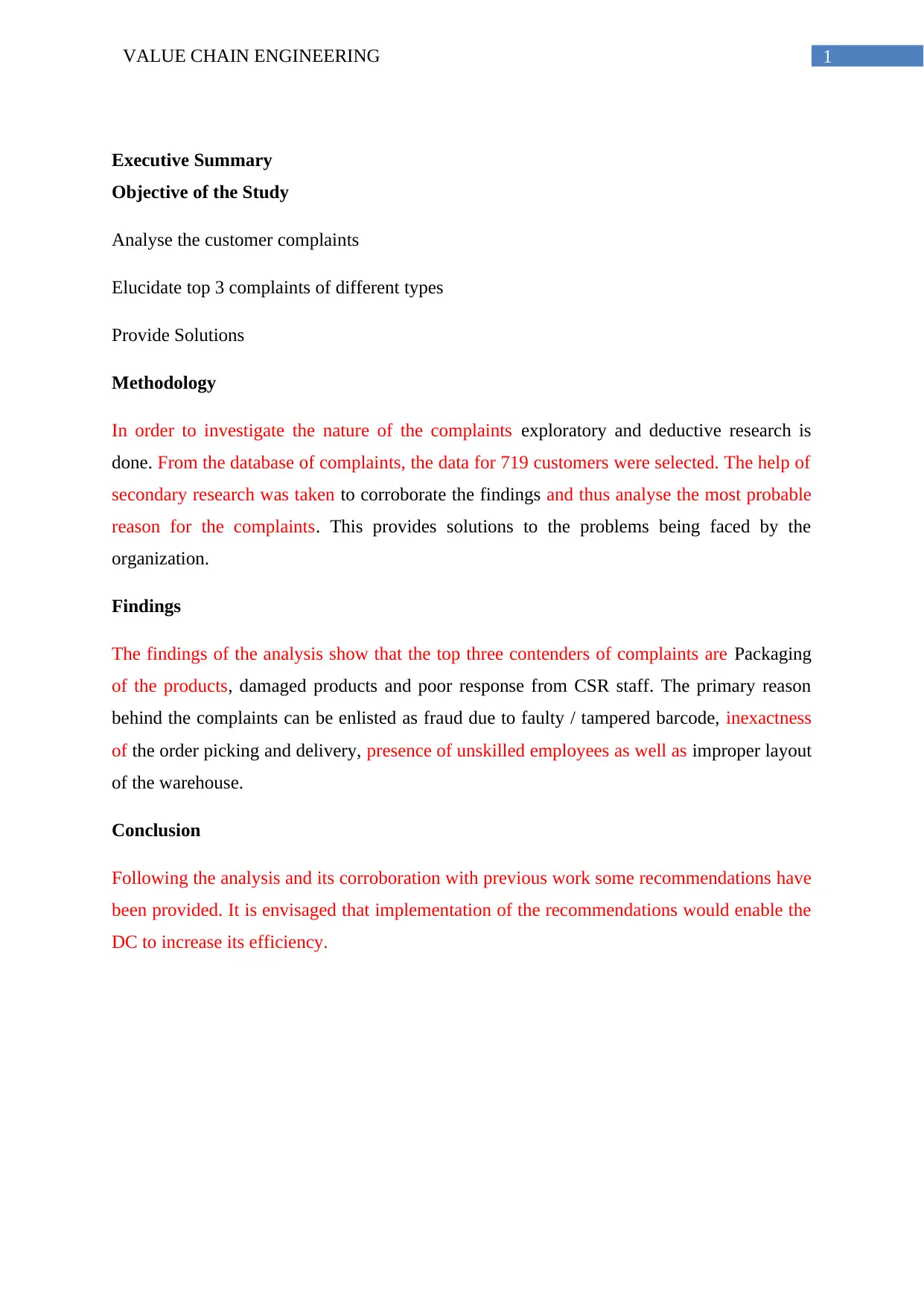
1VALUE CHAIN ENGINEERING
Executive Summary
Objective of the Study
Analyse the customer complaints
Elucidate top 3 complaints of different types
Provide Solutions
Methodology
In order to investigate the nature of the complaints exploratory and deductive research is
done. From the database of complaints, the data for 719 customers were selected. The help of
secondary research was taken to corroborate the findings and thus analyse the most probable
reason for the complaints. This provides solutions to the problems being faced by the
organization.
Findings
The findings of the analysis show that the top three contenders of complaints are Packaging
of the products, damaged products and poor response from CSR staff. The primary reason
behind the complaints can be enlisted as fraud due to faulty / tampered barcode, inexactness
of the order picking and delivery, presence of unskilled employees as well as improper layout
of the warehouse.
Conclusion
Following the analysis and its corroboration with previous work some recommendations have
been provided. It is envisaged that implementation of the recommendations would enable the
DC to increase its efficiency.
Executive Summary
Objective of the Study
Analyse the customer complaints
Elucidate top 3 complaints of different types
Provide Solutions
Methodology
In order to investigate the nature of the complaints exploratory and deductive research is
done. From the database of complaints, the data for 719 customers were selected. The help of
secondary research was taken to corroborate the findings and thus analyse the most probable
reason for the complaints. This provides solutions to the problems being faced by the
organization.
Findings
The findings of the analysis show that the top three contenders of complaints are Packaging
of the products, damaged products and poor response from CSR staff. The primary reason
behind the complaints can be enlisted as fraud due to faulty / tampered barcode, inexactness
of the order picking and delivery, presence of unskilled employees as well as improper layout
of the warehouse.
Conclusion
Following the analysis and its corroboration with previous work some recommendations have
been provided. It is envisaged that implementation of the recommendations would enable the
DC to increase its efficiency.
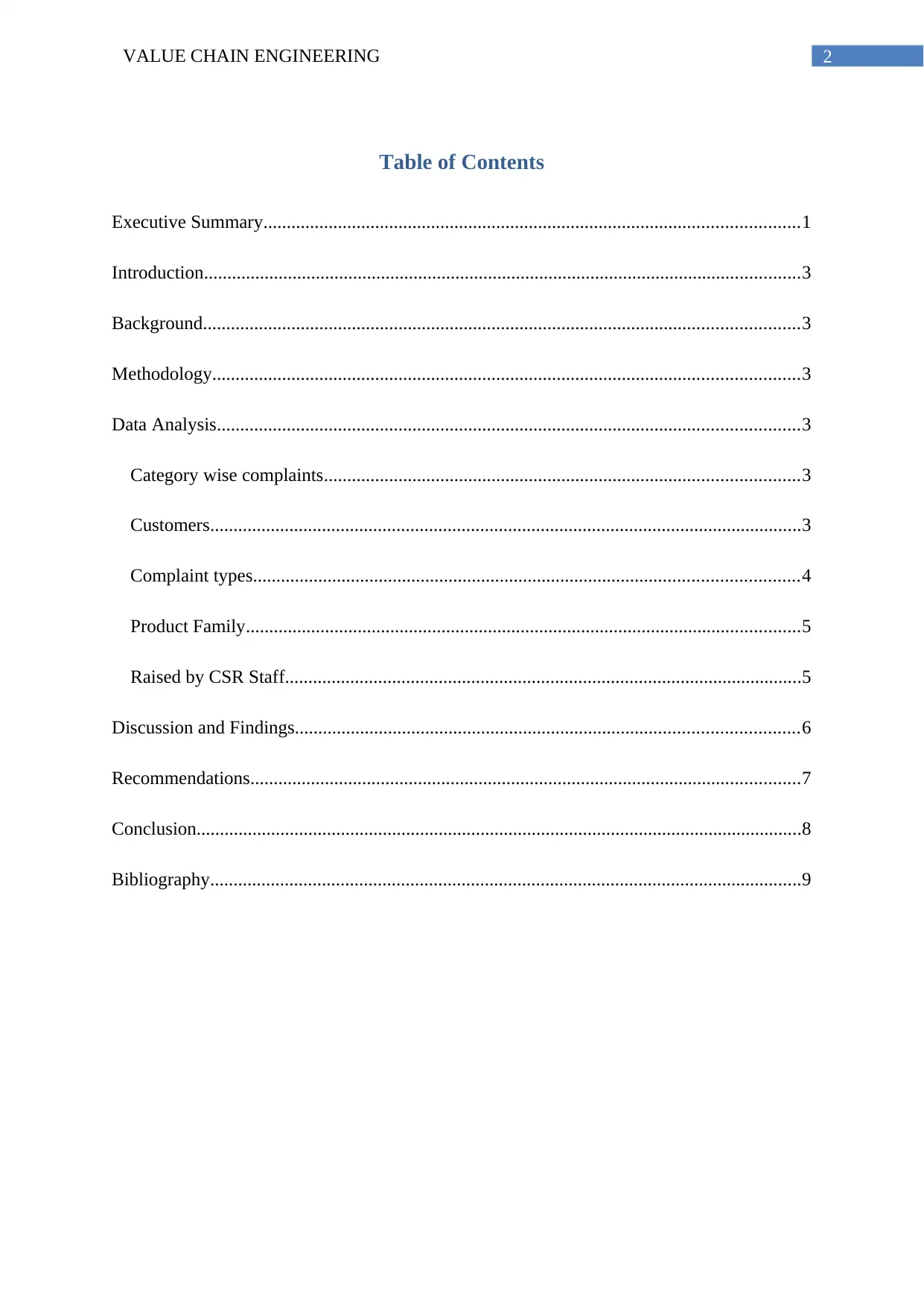
2VALUE CHAIN ENGINEERING
Table of Contents
Executive Summary...................................................................................................................1
Introduction................................................................................................................................3
Background................................................................................................................................3
Methodology..............................................................................................................................3
Data Analysis.............................................................................................................................3
Category wise complaints......................................................................................................3
Customers...............................................................................................................................3
Complaint types.....................................................................................................................4
Product Family.......................................................................................................................5
Raised by CSR Staff...............................................................................................................5
Discussion and Findings............................................................................................................6
Recommendations......................................................................................................................7
Conclusion..................................................................................................................................8
Bibliography...............................................................................................................................9
Table of Contents
Executive Summary...................................................................................................................1
Introduction................................................................................................................................3
Background................................................................................................................................3
Methodology..............................................................................................................................3
Data Analysis.............................................................................................................................3
Category wise complaints......................................................................................................3
Customers...............................................................................................................................3
Complaint types.....................................................................................................................4
Product Family.......................................................................................................................5
Raised by CSR Staff...............................................................................................................5
Discussion and Findings............................................................................................................6
Recommendations......................................................................................................................7
Conclusion..................................................................................................................................8
Bibliography...............................................................................................................................9
⊘ This is a preview!⊘
Do you want full access?
Subscribe today to unlock all pages.

Trusted by 1+ million students worldwide
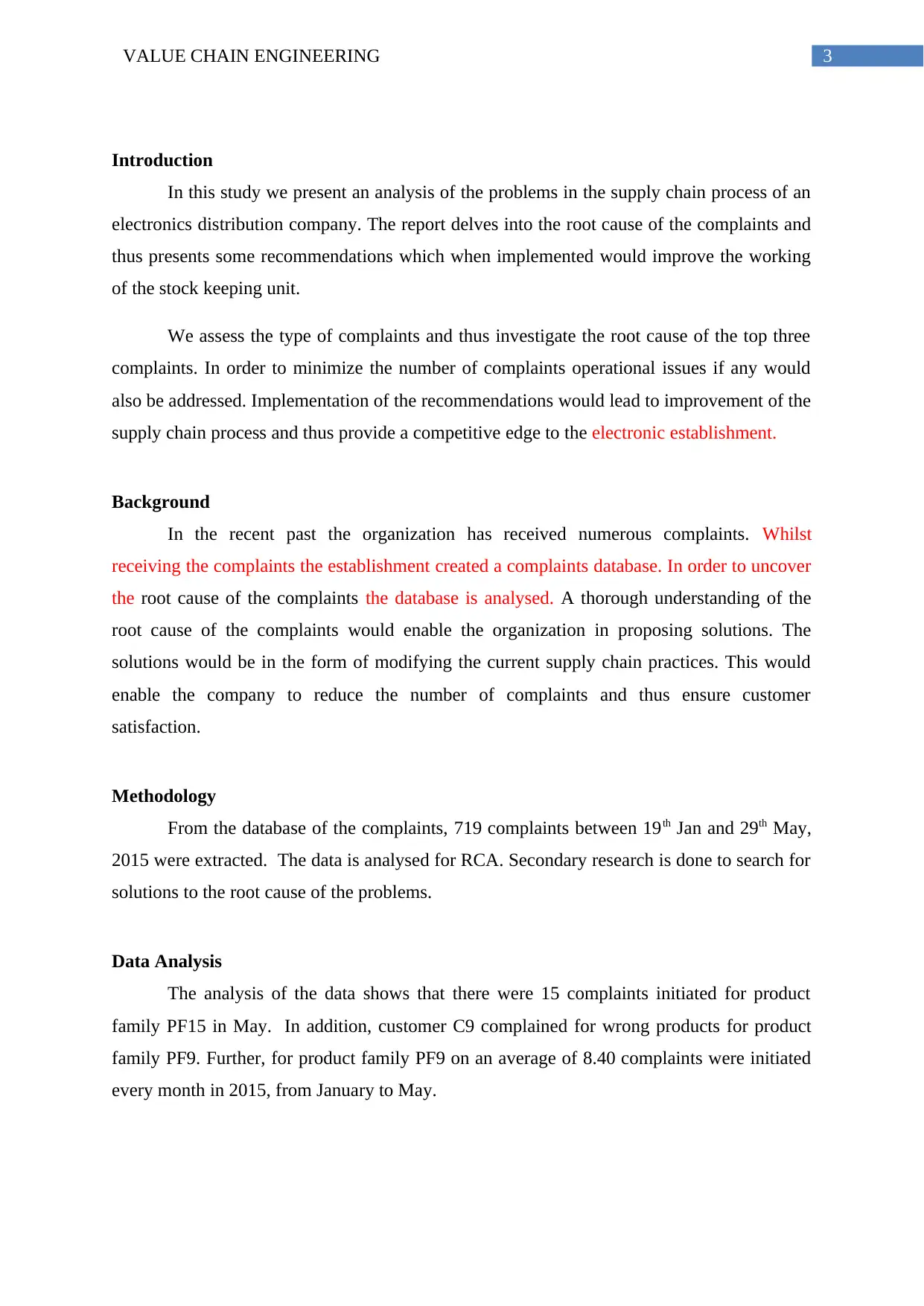
3VALUE CHAIN ENGINEERING
Introduction
In this study we present an analysis of the problems in the supply chain process of an
electronics distribution company. The report delves into the root cause of the complaints and
thus presents some recommendations which when implemented would improve the working
of the stock keeping unit.
We assess the type of complaints and thus investigate the root cause of the top three
complaints. In order to minimize the number of complaints operational issues if any would
also be addressed. Implementation of the recommendations would lead to improvement of the
supply chain process and thus provide a competitive edge to the electronic establishment.
Background
In the recent past the organization has received numerous complaints. Whilst
receiving the complaints the establishment created a complaints database. In order to uncover
the root cause of the complaints the database is analysed. A thorough understanding of the
root cause of the complaints would enable the organization in proposing solutions. The
solutions would be in the form of modifying the current supply chain practices. This would
enable the company to reduce the number of complaints and thus ensure customer
satisfaction.
Methodology
From the database of the complaints, 719 complaints between 19th Jan and 29th May,
2015 were extracted. The data is analysed for RCA. Secondary research is done to search for
solutions to the root cause of the problems.
Data Analysis
The analysis of the data shows that there were 15 complaints initiated for product
family PF15 in May. In addition, customer C9 complained for wrong products for product
family PF9. Further, for product family PF9 on an average of 8.40 complaints were initiated
every month in 2015, from January to May.
Introduction
In this study we present an analysis of the problems in the supply chain process of an
electronics distribution company. The report delves into the root cause of the complaints and
thus presents some recommendations which when implemented would improve the working
of the stock keeping unit.
We assess the type of complaints and thus investigate the root cause of the top three
complaints. In order to minimize the number of complaints operational issues if any would
also be addressed. Implementation of the recommendations would lead to improvement of the
supply chain process and thus provide a competitive edge to the electronic establishment.
Background
In the recent past the organization has received numerous complaints. Whilst
receiving the complaints the establishment created a complaints database. In order to uncover
the root cause of the complaints the database is analysed. A thorough understanding of the
root cause of the complaints would enable the organization in proposing solutions. The
solutions would be in the form of modifying the current supply chain practices. This would
enable the company to reduce the number of complaints and thus ensure customer
satisfaction.
Methodology
From the database of the complaints, 719 complaints between 19th Jan and 29th May,
2015 were extracted. The data is analysed for RCA. Secondary research is done to search for
solutions to the root cause of the problems.
Data Analysis
The analysis of the data shows that there were 15 complaints initiated for product
family PF15 in May. In addition, customer C9 complained for wrong products for product
family PF9. Further, for product family PF9 on an average of 8.40 complaints were initiated
every month in 2015, from January to May.
Paraphrase This Document
Need a fresh take? Get an instant paraphrase of this document with our AI Paraphraser
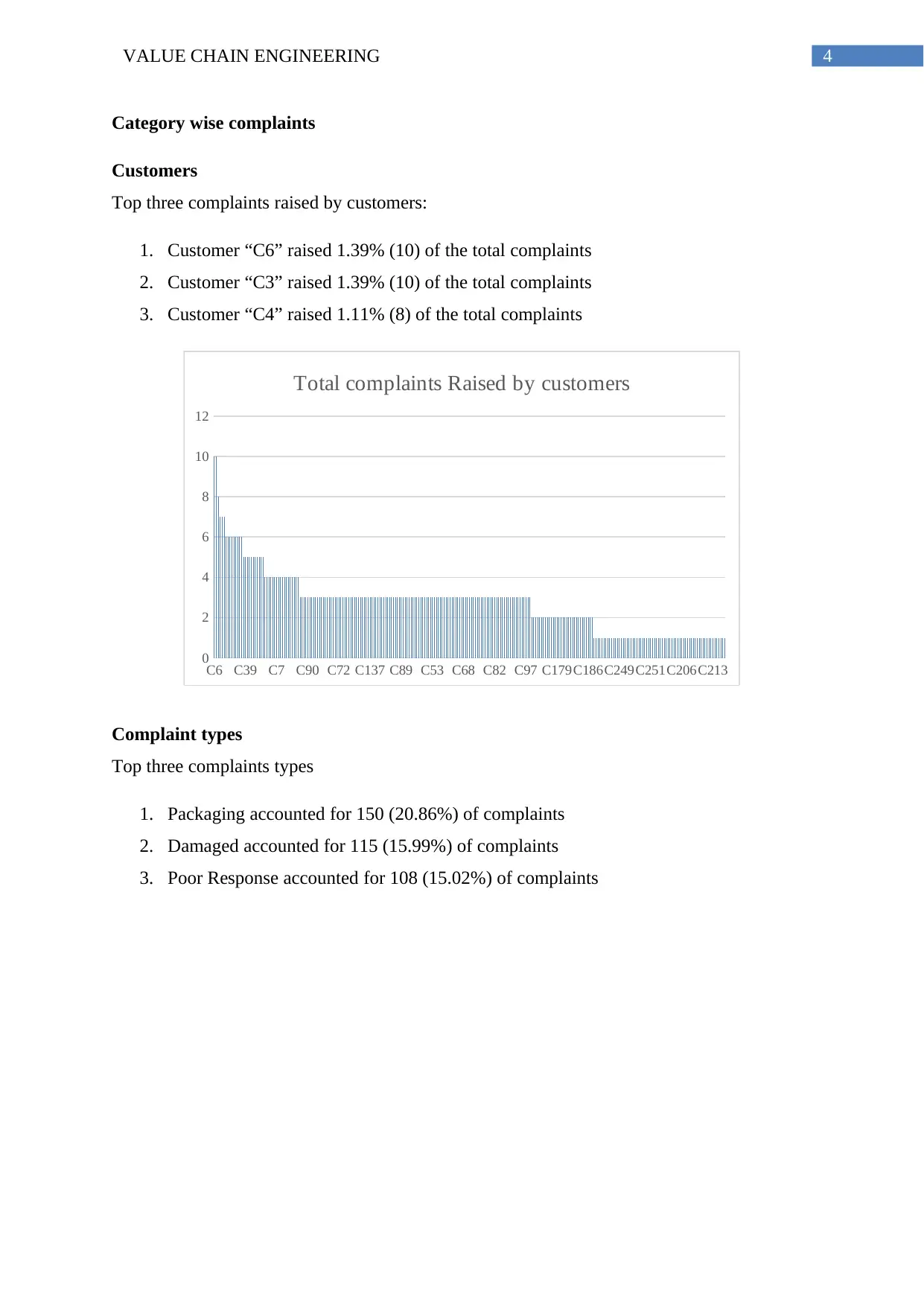
4VALUE CHAIN ENGINEERING
Category wise complaints
Customers
Top three complaints raised by customers:
1. Customer “C6” raised 1.39% (10) of the total complaints
2. Customer “C3” raised 1.39% (10) of the total complaints
3. Customer “C4” raised 1.11% (8) of the total complaints
C6 C39 C7 C90 C72 C137 C89 C53 C68 C82 C97 C179C186C249C251C206C213
0
2
4
6
8
10
12
Total complaints Raised by customers
Complaint types
Top three complaints types
1. Packaging accounted for 150 (20.86%) of complaints
2. Damaged accounted for 115 (15.99%) of complaints
3. Poor Response accounted for 108 (15.02%) of complaints
Category wise complaints
Customers
Top three complaints raised by customers:
1. Customer “C6” raised 1.39% (10) of the total complaints
2. Customer “C3” raised 1.39% (10) of the total complaints
3. Customer “C4” raised 1.11% (8) of the total complaints
C6 C39 C7 C90 C72 C137 C89 C53 C68 C82 C97 C179C186C249C251C206C213
0
2
4
6
8
10
12
Total complaints Raised by customers
Complaint types
Top three complaints types
1. Packaging accounted for 150 (20.86%) of complaints
2. Damaged accounted for 115 (15.99%) of complaints
3. Poor Response accounted for 108 (15.02%) of complaints
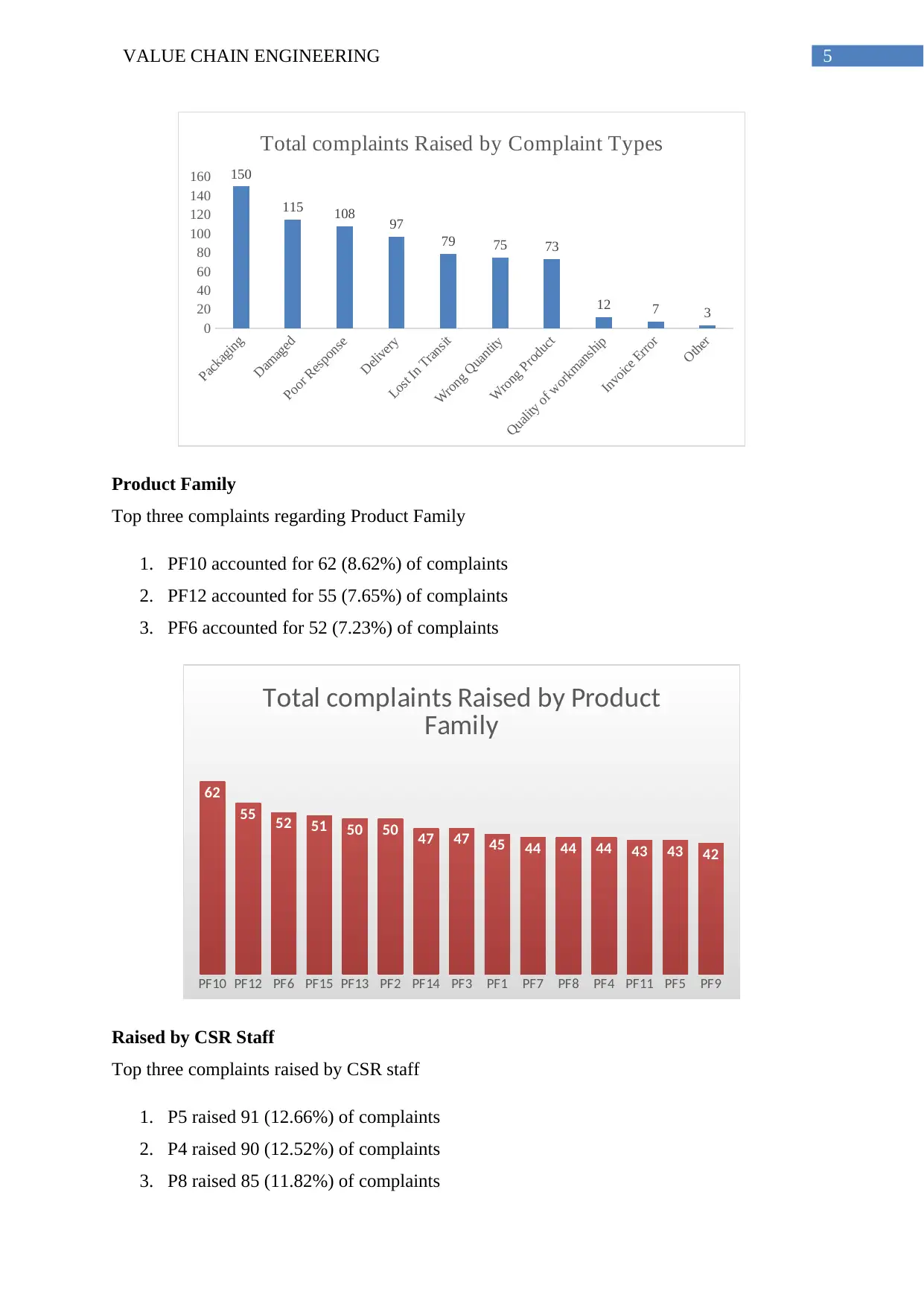
5VALUE CHAIN ENGINEERING
Packaging
Damaged
Poor Response
Delivery
Lost In Transit
Wrong Quantity
Wrong Product
Quality of workmanship
Invoice Error
Other
0
20
40
60
80
100
120
140
160 150
115 108 97
79 75 73
12 7 3
Total complaints Raised by Complaint Types
Product Family
Top three complaints regarding Product Family
1. PF10 accounted for 62 (8.62%) of complaints
2. PF12 accounted for 55 (7.65%) of complaints
3. PF6 accounted for 52 (7.23%) of complaints
PF10 PF12 PF6 PF15 PF13 PF2 PF14 PF3 PF1 PF7 PF8 PF4 PF11 PF5 PF9
62
55 52 51 50 50 47 47 45 44 44 44 43 43 42
Total complaints Raised by Product
Family
Raised by CSR Staff
Top three complaints raised by CSR staff
1. P5 raised 91 (12.66%) of complaints
2. P4 raised 90 (12.52%) of complaints
3. P8 raised 85 (11.82%) of complaints
Packaging
Damaged
Poor Response
Delivery
Lost In Transit
Wrong Quantity
Wrong Product
Quality of workmanship
Invoice Error
Other
0
20
40
60
80
100
120
140
160 150
115 108 97
79 75 73
12 7 3
Total complaints Raised by Complaint Types
Product Family
Top three complaints regarding Product Family
1. PF10 accounted for 62 (8.62%) of complaints
2. PF12 accounted for 55 (7.65%) of complaints
3. PF6 accounted for 52 (7.23%) of complaints
PF10 PF12 PF6 PF15 PF13 PF2 PF14 PF3 PF1 PF7 PF8 PF4 PF11 PF5 PF9
62
55 52 51 50 50 47 47 45 44 44 44 43 43 42
Total complaints Raised by Product
Family
Raised by CSR Staff
Top three complaints raised by CSR staff
1. P5 raised 91 (12.66%) of complaints
2. P4 raised 90 (12.52%) of complaints
3. P8 raised 85 (11.82%) of complaints
⊘ This is a preview!⊘
Do you want full access?
Subscribe today to unlock all pages.

Trusted by 1+ million students worldwide
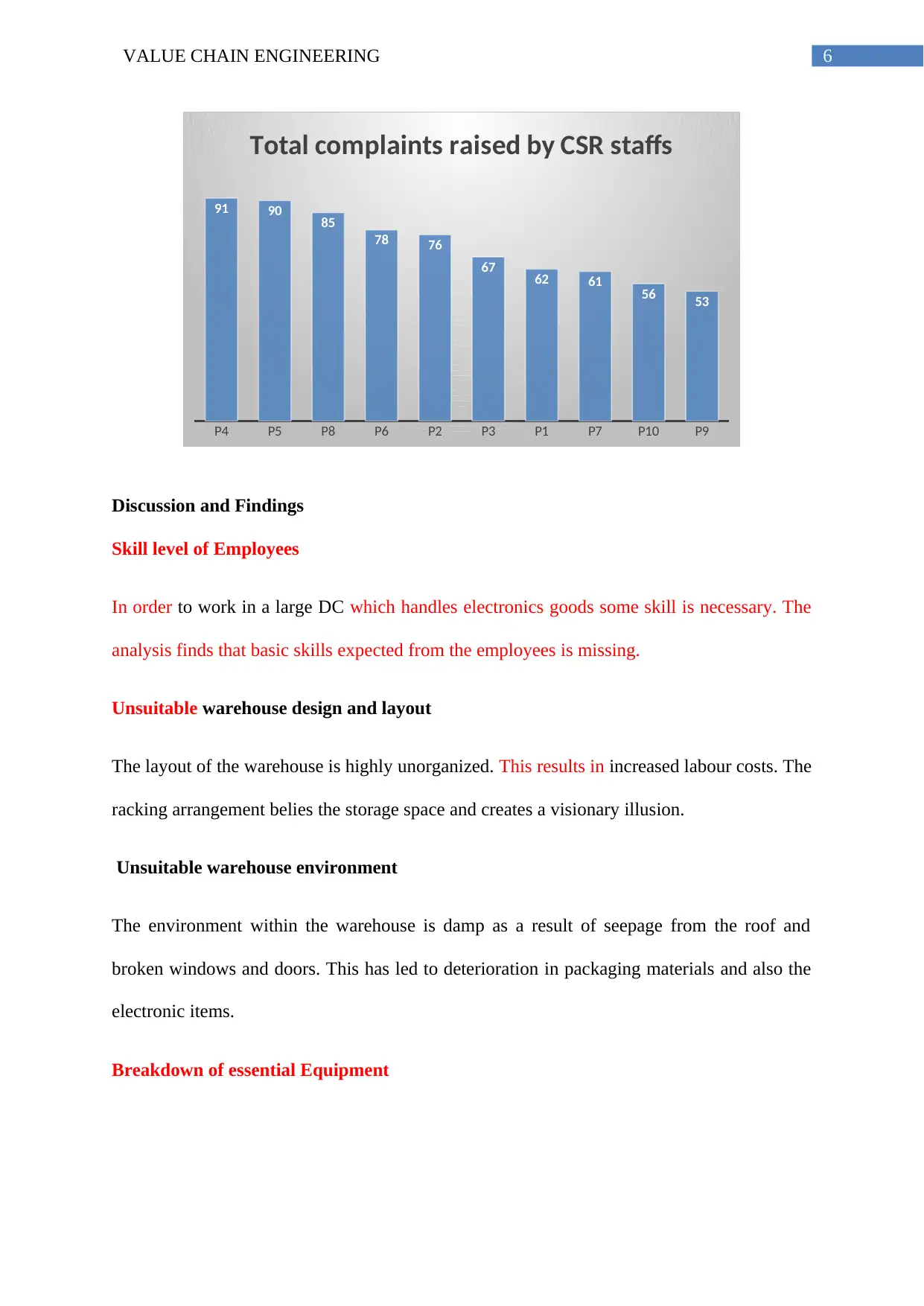
6VALUE CHAIN ENGINEERING
P4 P5 P8 P6 P2 P3 P1 P7 P10 P9
91 90 85
78 76
67 62 61 56 53
Total complaints raised by CSR staffs
Discussion and Findings
Skill level of Employees
In order to work in a large DC which handles electronics goods some skill is necessary. The
analysis finds that basic skills expected from the employees is missing.
Unsuitable warehouse design and layout
The layout of the warehouse is highly unorganized. This results in increased labour costs. The
racking arrangement belies the storage space and creates a visionary illusion.
Unsuitable warehouse environment
The environment within the warehouse is damp as a result of seepage from the roof and
broken windows and doors. This has led to deterioration in packaging materials and also the
electronic items.
Breakdown of essential Equipment
P4 P5 P8 P6 P2 P3 P1 P7 P10 P9
91 90 85
78 76
67 62 61 56 53
Total complaints raised by CSR staffs
Discussion and Findings
Skill level of Employees
In order to work in a large DC which handles electronics goods some skill is necessary. The
analysis finds that basic skills expected from the employees is missing.
Unsuitable warehouse design and layout
The layout of the warehouse is highly unorganized. This results in increased labour costs. The
racking arrangement belies the storage space and creates a visionary illusion.
Unsuitable warehouse environment
The environment within the warehouse is damp as a result of seepage from the roof and
broken windows and doors. This has led to deterioration in packaging materials and also the
electronic items.
Breakdown of essential Equipment
Paraphrase This Document
Need a fresh take? Get an instant paraphrase of this document with our AI Paraphraser
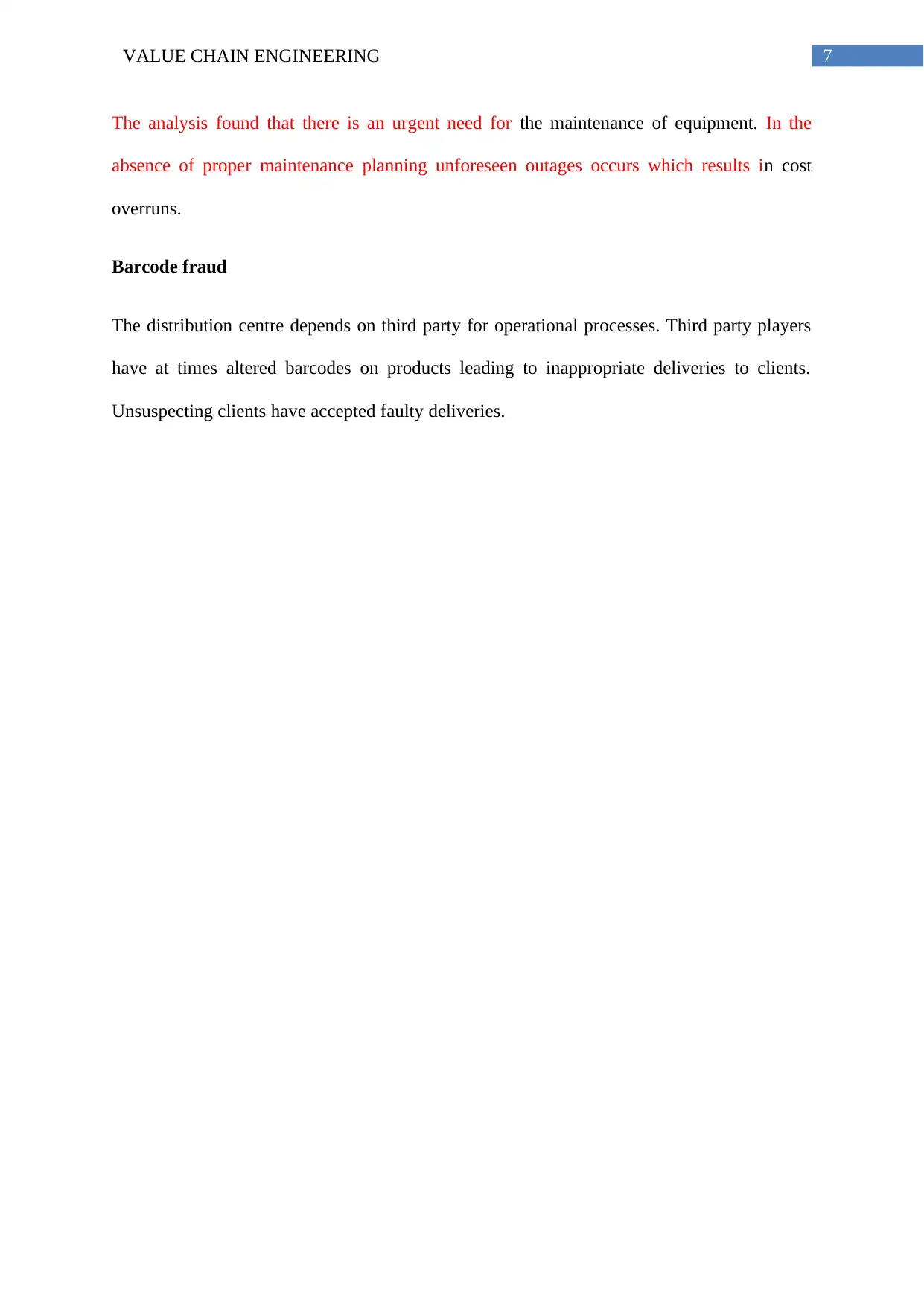
7VALUE CHAIN ENGINEERING
The analysis found that there is an urgent need for the maintenance of equipment. In the
absence of proper maintenance planning unforeseen outages occurs which results in cost
overruns.
Barcode fraud
The distribution centre depends on third party for operational processes. Third party players
have at times altered barcodes on products leading to inappropriate deliveries to clients.
Unsuspecting clients have accepted faulty deliveries.
The analysis found that there is an urgent need for the maintenance of equipment. In the
absence of proper maintenance planning unforeseen outages occurs which results in cost
overruns.
Barcode fraud
The distribution centre depends on third party for operational processes. Third party players
have at times altered barcodes on products leading to inappropriate deliveries to clients.
Unsuspecting clients have accepted faulty deliveries.
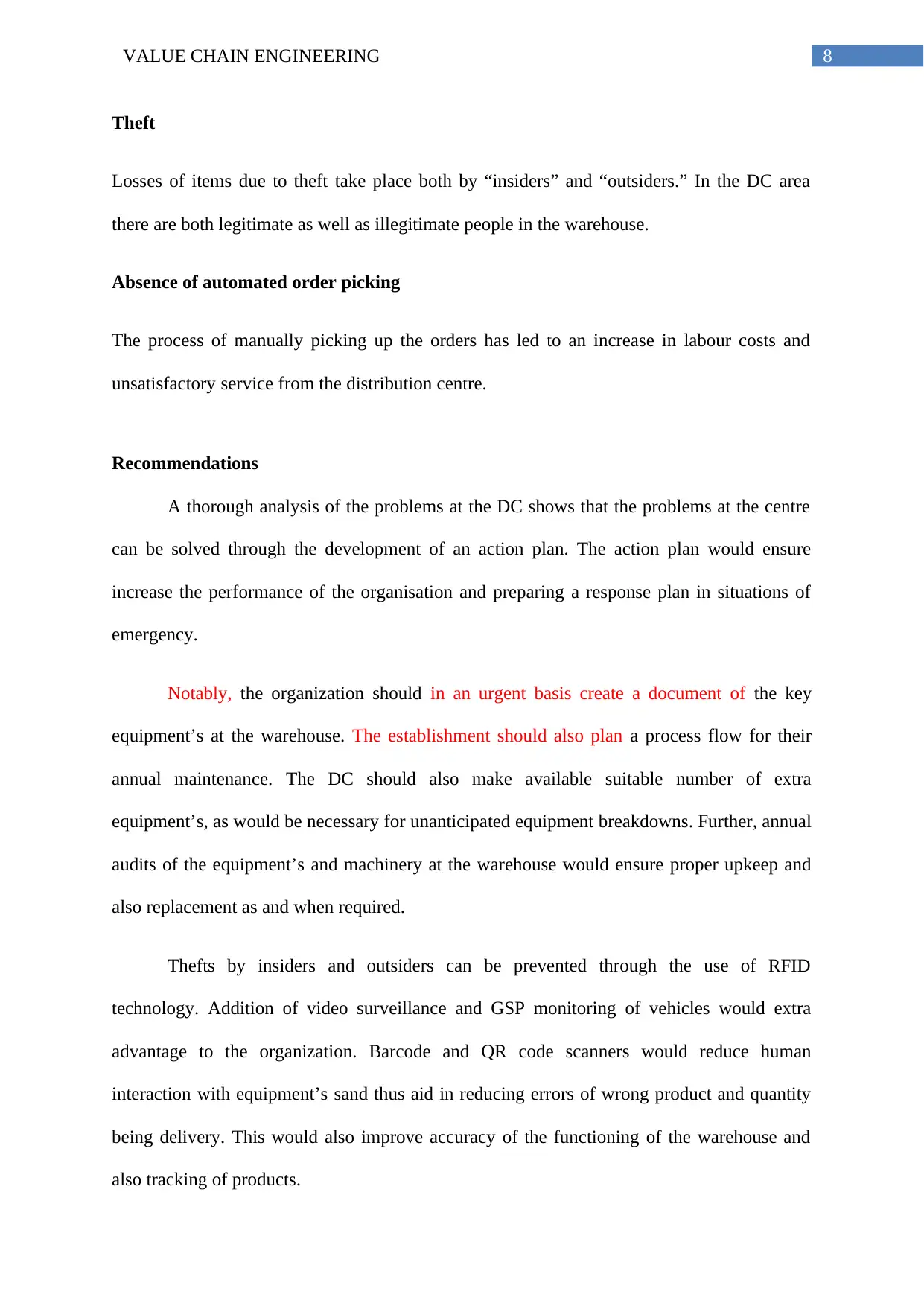
8VALUE CHAIN ENGINEERING
Theft
Losses of items due to theft take place both by “insiders” and “outsiders.” In the DC area
there are both legitimate as well as illegitimate people in the warehouse.
Absence of automated order picking
The process of manually picking up the orders has led to an increase in labour costs and
unsatisfactory service from the distribution centre.
Recommendations
A thorough analysis of the problems at the DC shows that the problems at the centre
can be solved through the development of an action plan. The action plan would ensure
increase the performance of the organisation and preparing a response plan in situations of
emergency.
Notably, the organization should in an urgent basis create a document of the key
equipment’s at the warehouse. The establishment should also plan a process flow for their
annual maintenance. The DC should also make available suitable number of extra
equipment’s, as would be necessary for unanticipated equipment breakdowns. Further, annual
audits of the equipment’s and machinery at the warehouse would ensure proper upkeep and
also replacement as and when required.
Thefts by insiders and outsiders can be prevented through the use of RFID
technology. Addition of video surveillance and GSP monitoring of vehicles would extra
advantage to the organization. Barcode and QR code scanners would reduce human
interaction with equipment’s sand thus aid in reducing errors of wrong product and quantity
being delivery. This would also improve accuracy of the functioning of the warehouse and
also tracking of products.
Theft
Losses of items due to theft take place both by “insiders” and “outsiders.” In the DC area
there are both legitimate as well as illegitimate people in the warehouse.
Absence of automated order picking
The process of manually picking up the orders has led to an increase in labour costs and
unsatisfactory service from the distribution centre.
Recommendations
A thorough analysis of the problems at the DC shows that the problems at the centre
can be solved through the development of an action plan. The action plan would ensure
increase the performance of the organisation and preparing a response plan in situations of
emergency.
Notably, the organization should in an urgent basis create a document of the key
equipment’s at the warehouse. The establishment should also plan a process flow for their
annual maintenance. The DC should also make available suitable number of extra
equipment’s, as would be necessary for unanticipated equipment breakdowns. Further, annual
audits of the equipment’s and machinery at the warehouse would ensure proper upkeep and
also replacement as and when required.
Thefts by insiders and outsiders can be prevented through the use of RFID
technology. Addition of video surveillance and GSP monitoring of vehicles would extra
advantage to the organization. Barcode and QR code scanners would reduce human
interaction with equipment’s sand thus aid in reducing errors of wrong product and quantity
being delivery. This would also improve accuracy of the functioning of the warehouse and
also tracking of products.
⊘ This is a preview!⊘
Do you want full access?
Subscribe today to unlock all pages.

Trusted by 1+ million students worldwide
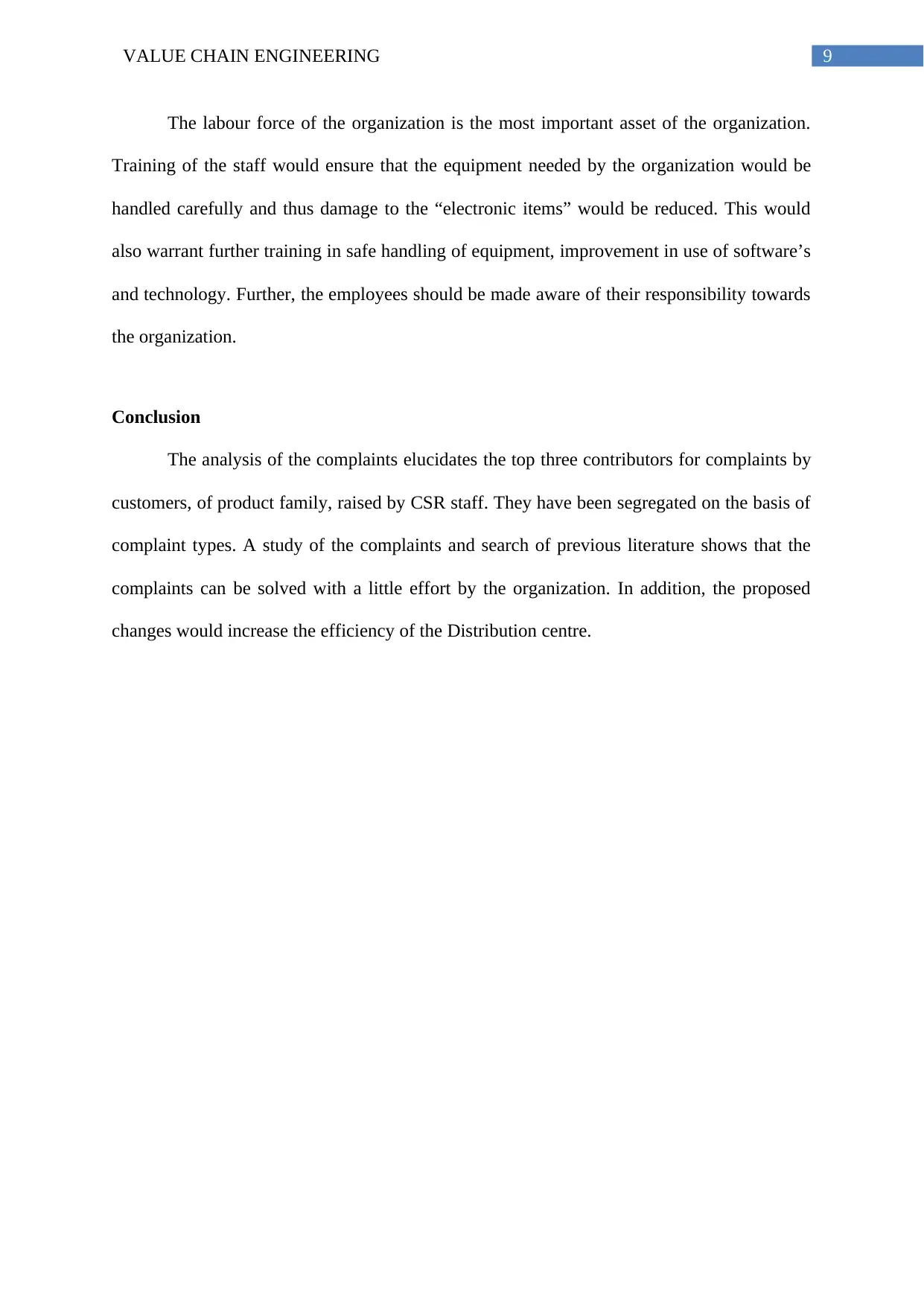
9VALUE CHAIN ENGINEERING
The labour force of the organization is the most important asset of the organization.
Training of the staff would ensure that the equipment needed by the organization would be
handled carefully and thus damage to the “electronic items” would be reduced. This would
also warrant further training in safe handling of equipment, improvement in use of software’s
and technology. Further, the employees should be made aware of their responsibility towards
the organization.
Conclusion
The analysis of the complaints elucidates the top three contributors for complaints by
customers, of product family, raised by CSR staff. They have been segregated on the basis of
complaint types. A study of the complaints and search of previous literature shows that the
complaints can be solved with a little effort by the organization. In addition, the proposed
changes would increase the efficiency of the Distribution centre.
The labour force of the organization is the most important asset of the organization.
Training of the staff would ensure that the equipment needed by the organization would be
handled carefully and thus damage to the “electronic items” would be reduced. This would
also warrant further training in safe handling of equipment, improvement in use of software’s
and technology. Further, the employees should be made aware of their responsibility towards
the organization.
Conclusion
The analysis of the complaints elucidates the top three contributors for complaints by
customers, of product family, raised by CSR staff. They have been segregated on the basis of
complaint types. A study of the complaints and search of previous literature shows that the
complaints can be solved with a little effort by the organization. In addition, the proposed
changes would increase the efficiency of the Distribution centre.
Paraphrase This Document
Need a fresh take? Get an instant paraphrase of this document with our AI Paraphraser
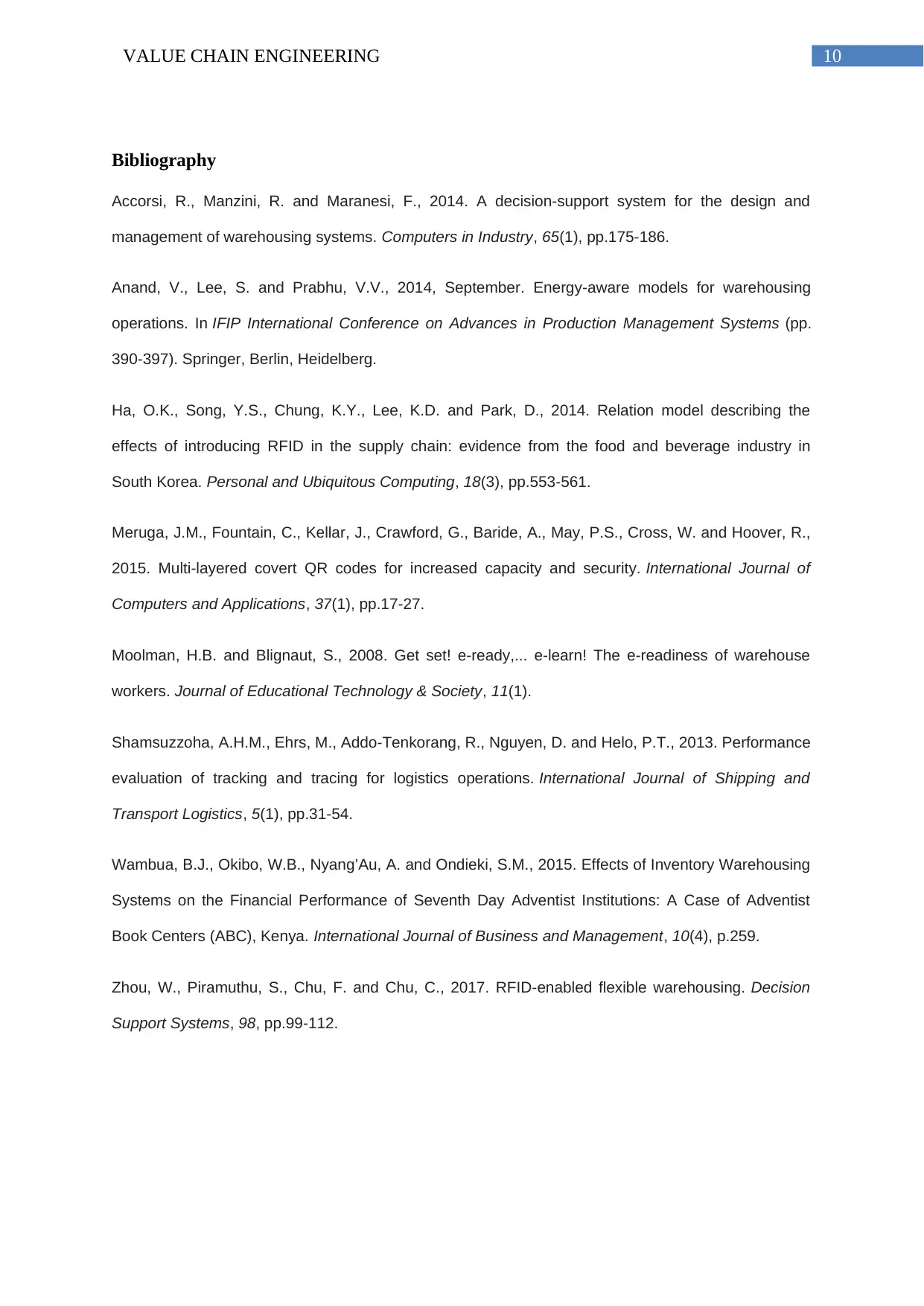
10VALUE CHAIN ENGINEERING
Bibliography
Accorsi, R., Manzini, R. and Maranesi, F., 2014. A decision-support system for the design and
management of warehousing systems. Computers in Industry, 65(1), pp.175-186.
Anand, V., Lee, S. and Prabhu, V.V., 2014, September. Energy-aware models for warehousing
operations. In IFIP International Conference on Advances in Production Management Systems (pp.
390-397). Springer, Berlin, Heidelberg.
Ha, O.K., Song, Y.S., Chung, K.Y., Lee, K.D. and Park, D., 2014. Relation model describing the
effects of introducing RFID in the supply chain: evidence from the food and beverage industry in
South Korea. Personal and Ubiquitous Computing, 18(3), pp.553-561.
Meruga, J.M., Fountain, C., Kellar, J., Crawford, G., Baride, A., May, P.S., Cross, W. and Hoover, R.,
2015. Multi-layered covert QR codes for increased capacity and security. International Journal of
Computers and Applications, 37(1), pp.17-27.
Moolman, H.B. and Blignaut, S., 2008. Get set! e-ready,... e-learn! The e-readiness of warehouse
workers. Journal of Educational Technology & Society, 11(1).
Shamsuzzoha, A.H.M., Ehrs, M., Addo-Tenkorang, R., Nguyen, D. and Helo, P.T., 2013. Performance
evaluation of tracking and tracing for logistics operations. International Journal of Shipping and
Transport Logistics, 5(1), pp.31-54.
Wambua, B.J., Okibo, W.B., Nyang’Au, A. and Ondieki, S.M., 2015. Effects of Inventory Warehousing
Systems on the Financial Performance of Seventh Day Adventist Institutions: A Case of Adventist
Book Centers (ABC), Kenya. International Journal of Business and Management, 10(4), p.259.
Zhou, W., Piramuthu, S., Chu, F. and Chu, C., 2017. RFID-enabled flexible warehousing. Decision
Support Systems, 98, pp.99-112.
Bibliography
Accorsi, R., Manzini, R. and Maranesi, F., 2014. A decision-support system for the design and
management of warehousing systems. Computers in Industry, 65(1), pp.175-186.
Anand, V., Lee, S. and Prabhu, V.V., 2014, September. Energy-aware models for warehousing
operations. In IFIP International Conference on Advances in Production Management Systems (pp.
390-397). Springer, Berlin, Heidelberg.
Ha, O.K., Song, Y.S., Chung, K.Y., Lee, K.D. and Park, D., 2014. Relation model describing the
effects of introducing RFID in the supply chain: evidence from the food and beverage industry in
South Korea. Personal and Ubiquitous Computing, 18(3), pp.553-561.
Meruga, J.M., Fountain, C., Kellar, J., Crawford, G., Baride, A., May, P.S., Cross, W. and Hoover, R.,
2015. Multi-layered covert QR codes for increased capacity and security. International Journal of
Computers and Applications, 37(1), pp.17-27.
Moolman, H.B. and Blignaut, S., 2008. Get set! e-ready,... e-learn! The e-readiness of warehouse
workers. Journal of Educational Technology & Society, 11(1).
Shamsuzzoha, A.H.M., Ehrs, M., Addo-Tenkorang, R., Nguyen, D. and Helo, P.T., 2013. Performance
evaluation of tracking and tracing for logistics operations. International Journal of Shipping and
Transport Logistics, 5(1), pp.31-54.
Wambua, B.J., Okibo, W.B., Nyang’Au, A. and Ondieki, S.M., 2015. Effects of Inventory Warehousing
Systems on the Financial Performance of Seventh Day Adventist Institutions: A Case of Adventist
Book Centers (ABC), Kenya. International Journal of Business and Management, 10(4), p.259.
Zhou, W., Piramuthu, S., Chu, F. and Chu, C., 2017. RFID-enabled flexible warehousing. Decision
Support Systems, 98, pp.99-112.
1 out of 11
Related Documents
Your All-in-One AI-Powered Toolkit for Academic Success.
+13062052269
info@desklib.com
Available 24*7 on WhatsApp / Email
![[object Object]](/_next/static/media/star-bottom.7253800d.svg)
Unlock your academic potential
Copyright © 2020–2025 A2Z Services. All Rights Reserved. Developed and managed by ZUCOL.




